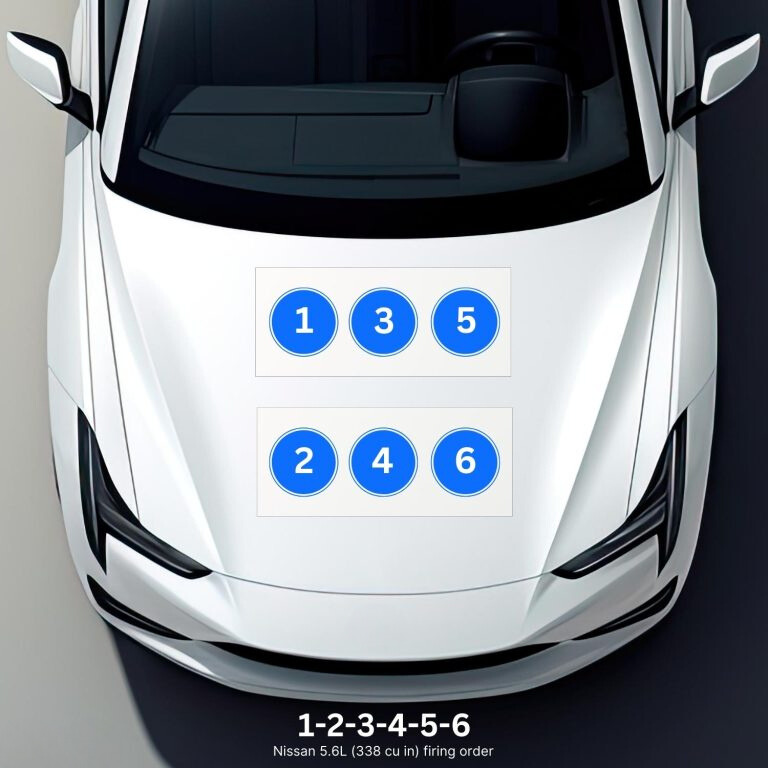The Nissan Murano, a stylish and versatile midsize crossover SUV, is powered by a reliable V6 engine from Nissan’s acclaimed VQ series. Whether you’re a Murano owner or a car enthusiast, understanding the firing order of the engine can help you grasp how the vehicle delivers its smooth performance and efficiency. This guide explores the firing order of the Nissan Murano, explaining its importance, how it works, and tips for maintenance.

Quick Navigation
What is a Firing Order?
The firing order refers to the sequence in which the engine’s cylinders ignite their air-fuel mixture during the combustion process. In the Nissan Murano’s VQ35DE or VQ35DD engines (depending on the model year), the firing order is 1-2-3-4-5-6.

This sequence is essential for ensuring the engine runs smoothly, delivering balanced power output and minimizing vibrations.
Why the Firing Order Matters
The firing order is a fundamental component of the engine’s operation. Here’s why it’s so important:
- Engine Balance: The firing order ensures even distribution of power strokes, reducing vibrations and improving stability.
- Power Delivery: Proper sequencing enables smooth and consistent torque output, enhancing acceleration and overall performance.
- Efficiency: A correct firing order promotes complete combustion, maximizing fuel economy and reducing emissions.
- Durability: Balanced operation minimizes stress on engine components, extending their lifespan.
- Smooth Performance: The firing order prevents misfires and rough idling, ensuring the engine operates reliably under various conditions.
Disrupting the firing order can lead to several performance issues, including misfires, power loss, and increased fuel consumption.
The Nissan Murano Firing Order: 1-2-3-4-5-6
The firing order for the Nissan Murano’s V6 engine, 1-2-3-4-5-6, reflects its straightforward cylinder arrangement. Here’s how the sequence works:
- Cylinder 1 Fires First: The firing process begins with Cylinder 1 igniting its air-fuel mixture during the power stroke.
- Cylinder 2 Fires Next: Cylinder 2 ignites, continuing the engine’s cycle.
- Cylinder 3 Engages: Cylinder 3 fires, ensuring smooth power delivery.
- Cylinder 4 Fires: Cylinder 4 follows, maintaining balance in the engine’s operation.
- Cylinder 5 Engages: Cylinder 5 ignites, contributing to consistent power strokes.
- Cylinder 6 Completes the Cycle: Finally, Cylinder 6 fires, and the sequence repeats.
This firing order ensures that the engine’s power strokes are evenly spaced, optimizing performance and minimizing engine vibrations.
How the Firing Order Works in the Nissan Murano Engine
The Nissan Murano’s V6 engine operates on a four-stroke cycle, which includes the following stages:
- Intake Stroke: The intake valve opens, allowing the air-fuel mixture to enter the cylinder.
- Compression Stroke: The piston compresses the mixture, preparing it for ignition.
- Power Stroke: The spark plug ignites the mixture, generating an explosion that drives the piston downward and creates power.
- Exhaust Stroke: The exhaust valve opens, releasing spent gases from the cylinder.
The firing order synchronizes these stages across all six cylinders. By following the 1-2-3-4-5-6 sequence, the engine ensures balanced and continuous power delivery, enhancing both performance and efficiency.
Key Components Supporting the Firing Order
Several components work together to execute the Nissan Murano’s firing order accurately. These include:
- Crankshaft: Converts the pistons’ linear motion into rotational energy and determines the sequence of power strokes.
- Camshaft: Times the opening and closing of the intake and exhaust valves, aligning them with the firing order.
- Ignition Coils: Deliver electrical energy to the spark plugs, ensuring the correct timing of ignition.
- Spark Plugs: Ignite the air-fuel mixture in each cylinder at the appropriate moment.
- Engine Control Unit (ECU): This electronic device manages the firing order, adjusting ignition timing and fuel delivery for optimal performance.
When these components function properly, the firing order ensures that the engine runs smoothly and efficiently.
Symptoms of Firing Order Problems
If the firing order is disrupted, the engine may display noticeable symptoms. Common signs of firing order issues include:
- Engine Misfires: Cylinders fail to ignite properly, causing uneven power delivery.
- Rough Idling: The engine may vibrate excessively or run inconsistently when idling.
- Power Loss: An incorrect firing order reduces efficiency, leading to sluggish acceleration.
- Backfiring: Faulty ignition timing may cause combustion gases to ignite in the intake or exhaust system.
- Excessive Vibrations: Imbalanced firing creates noticeable engine vibrations during operation.
Addressing these symptoms promptly can prevent further engine damage.
How to Verify the Firing Order
To confirm that the Nissan Murano’s firing order is correct, follow these steps:
- Inspect the Ignition Coils: Ensure each coil is connected to the correct cylinder.
- Check Spark Plugs: Verify that the spark plugs are clean, functional, and properly installed.
- Consult the Service Manual: The correct wiring diagram and cylinder numbering are in the Nissan Murano service manual.
- Use Diagnostic Tools: Modern diagnostic tools can detect misfires or incorrect ignition timing, making it easier to identify firing order issues.
- Listen for Unusual Noises: Sputtering, knocking, or other irregular sounds may indicate firing order problems.
Routine inspections and diagnostics help maintain the firing order and ensure optimal engine performance.
Maintaining the Firing Order
Proper maintenance is essential to preserve the Nissan Murano’s firing order. Here are practical tips to keep your engine running smoothly:
- Replace Spark Plugs as Needed: Worn or fouled spark plugs can disrupt the firing sequence and cause misfires.
- Inspect Ignition Coils Regularly: Look for signs of wear, cracks, or corrosion that could interfere with ignition.
- Monitor the ECU: Ensure the engine control unit is functioning correctly and update its software if necessary.
- Clean Fuel Injectors: Dirty fuel injectors may cause uneven fuel delivery, affecting combustion timing.
- Use High-Quality Fuel: Clean-burning fuel reduces carbon buildup, promoting efficient combustion.
Following these maintenance tips will help maintain your engine’s reliability and longevity.
Can You Modify the Firing Order?
The Nissan Murano’s firing order, 1-2-3-4-5-6, is specifically designed for its V6 configuration. Modifying this sequence is not recommended because:
- Imbalance Issues: Altering the firing order can cause excessive vibrations and instability.
- Reduced Efficiency: An incorrect sequence disrupts combustion, leading to power loss and increased fuel consumption.
- Potential Damage: Changes to the firing order may stress engine components, resulting in long-term damage.
If you’re seeking performance improvements, consider upgrades like ECU tuning, optimizing the intake and exhaust systems, or enhancing fuel delivery rather than altering the firing order.
Engines with Similar Firing Orders
- Nissan TD42 Firing Order
- 2005 Nissan Titan Firing Order
- 2004 Nissan Titan Firing Order
- 2004 Nissan Altima Firing Order
- 2003 Nissan Altima Firing Order
Conclusion
The Nissan Murano’s firing order, 1-2-3-4-5-6, is a fundamental part of its engine design. This sequence ensures balanced power delivery, smooth operation, and efficient combustion. Understanding how the firing order works and maintaining it properly is key to keeping your Murano performing at its best.
By following regular maintenance practices, addressing issues promptly, and using high-quality components, you can preserve the performance and longevity of your Nissan Murano engine. Whether driving for daily commutes or road trips, maintaining the correct firing order ensures your vehicle runs smoothly and efficiently for years to come.

